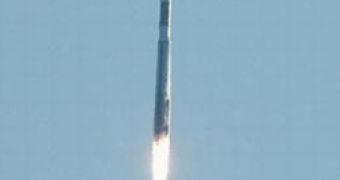A seven-month flight to Mars began this morning for NASA's Mars Reconnaissance Orbiter (MRO). It will inspect the red planet in fine detail and assist future landers.
An Atlas V launch vehicle, 19 stories tall with the two-ton spacecraft on top, roared away from Launch Complex 41 at Cape Canaveral Air Force Station at 7:43 a.m. EDT. Its powerful first stage consumed about 200 tons of fuel and oxygen in just over four minutes, then dropped away to let the upper stage finish the job of putting the spacecraft on a path toward Mars. This was the first launch of an interplanetary mission on an Atlas V.
"We have a healthy spacecraft on its way to Mars and a lot of happy people who made this possible," said James Graf, project manager for MRO at NASA's Jet Propulsion Laboratory (JPL), Pasadena, Calif.
MRO established radio contact with controllers 61 minutes after launch and within four minutes of separation from the upper stage. Initial contact came through an antenna at the Japan Aerospace Exploration Agency's Uchinoura Space Center in southern Japan.
Health and status information about the orbiter's subsystems were received through Uchinoura and the Goldstone, Calif., antenna station of NASA's Deep Space Network. By 14 minutes after separation, the craft's solar panels finished unfolding, enabling the MRO to start recharging batteries and operate as a fully functional spacecraft.
The orbiter carries six scientific instruments for examining the surface, atmosphere and subsurface of Mars in unprecedented detail from low orbit. For example, its high-resolution camera will reveal features as small as a dishwasher. NASA expects to get several times more data about Mars from MRO than from all previous Martian missions combined.
Mars is 72 million miles from Earth today, but the spacecraft will travel more than four times that distance on its outbound-arc trajectory to intercept the red planet on March 10, 2006. The cruise period will be busy with checkups, calibrations and trajectory adjustments.
The launch was originally scheduled for August 10, but was delayed first due to a gyroscope issue on a different Atlas V, and the next day because of a software glitch.

 14 DAY TRIAL //
14 DAY TRIAL //